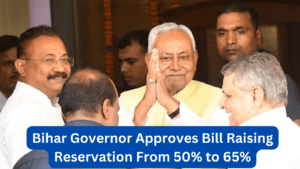Introduction:
On November 17, the Governor of Bihar, Rajendra Vishwanath Arlekar, gave his approval to the “Bihar Reservation Amendment Bill,” which is a crucial step towards resolving the issue of socioeconomic disparity.
During the winter season, the State Government unanimously passed the bill, and Chief Minister Nitish Kumar expressed his commitment to speedy implementation. This legislative development comes after the bill was passed.
To surpass the ceiling of fifty percent that was established by the Supreme Court, the law increases the reservation quota for Backward, Extremely Backward Classes, Scheduled Castes, and Scheduled Tribes from fifty percent to sixty-five percent.
The purpose of this essay is to examine the most important parts of the Reserve Amendment, including its ramifications and the social justice agenda that it intends to implement.
The Breakdown of the Quota
The ‘Bihar Reservation Amendment Bill’ is responsible for bringing about a thorough reevaluation of reservation quotas across a variety of categories.
The quotas for the Extremely Backward Class (EBC) have been increased from 18% to 25%, the quota for the Backward Classes (BC) has been increased from 12% to 18%, the quota for the Scheduled Caste (SC) has been increased from 16% to 20%, and the reservation for the Scheduled Tribe (ST) has been increased from 1% to 2%.
Notably, the British Columbia women’s reservation of three percent has been removed.
An Excessive Amount of Growth
As a result of the reservation quota of 65%, Bihar has exceeded the ceiling of 50% that was required by the Supreme Court.
However, Chief Minister Nitish Kumar has highlighted that the administration is committed to implementing the provisions of the bill, even though this raises issues about the constitutionality of such a step.
In this article, the potential legal repercussions of reserve quotas surpassing the allowed maximum are investigated, as well as the historical context of such a situation.
Influence on Educational Institutions and positions within the government
The revisions to the legislation not only apply to work prospects but also extend to educational institutions. In addition, bills that reflected the enhanced reservation in both sectors were overwhelmingly approved.
These bills were based on a comprehensive caste survey that was carried out by the state government.
The Vision of the Chief Minister
Nitish Kumar, the Chief Minister, made a promise that the terms of the bill would be implemented as quickly as possible after it was passed with unanimous approval on November 9.
On November 10, Kumar gave a speech to the House of Representatives in which he not only encouraged members to suggest a nationwide caste-based census to the federal government but also signaled his willingness to expand the quota limits even further if similar surveys were done across the country.
Survey Results Regarding Caste
The caste-based census that was carried out in Bihar revealed that the combined population of the state’s EBC and OBC groups accounts for a sizeable 63% of the total population, which is currently estimated to be 13.07 crores.
During the presentation of the survey report, Chief Minister Nitish Kumar stressed that the bill intends to adjust reservation quotas for backward classes based on their proportional representation in the population of the state.
Various Political Reactions
Former Chief Minister and HAM Chief Jitan Ram Manjhi made a statement urging the establishment of a new cabinet that reflects the share of the caste population upon the Governor’s approval of the Bihar Reservation Amendment Bill 2023.
The statement was issued after the Governor gave his approval to the bill. Manjhi made a caustic statement on social media in which she praised Nitish Kumar and urged that the existing cabinet be sacked.
She also suggested that a new council of ministers be created based on caste population shares, which would indicate a potential shift in the political dynamics.

















